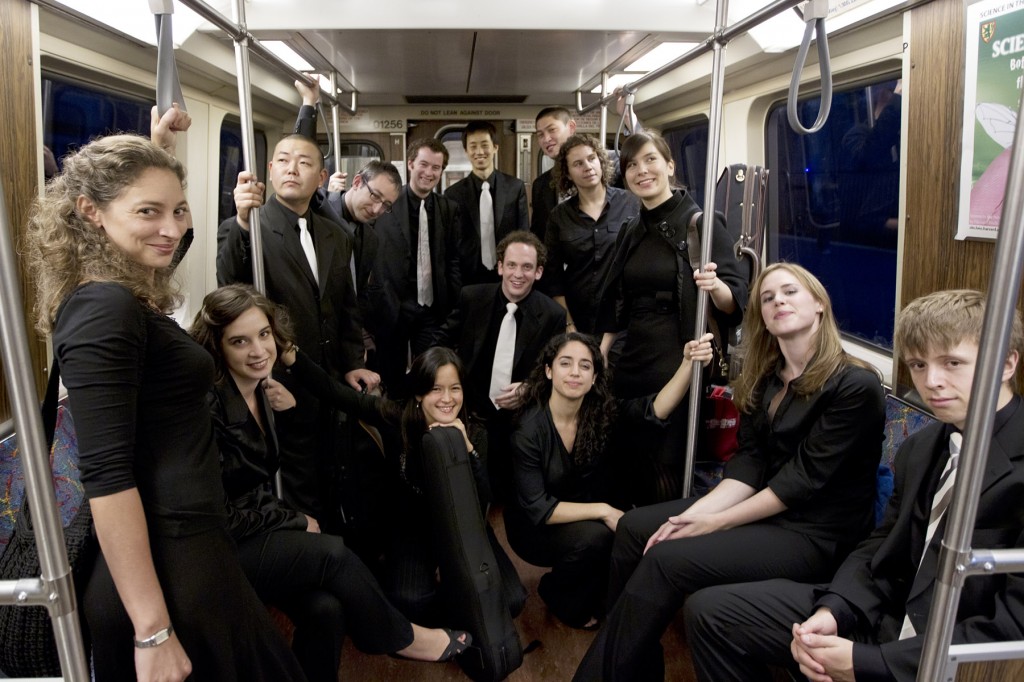A Far Cry displays string theory at Gardner Museum
“Thinking about the legacy of Baroque string virtuosity”—composer Andrew Norman’s description of his state of mind in a program note could be the motto for the concert given Thursday night by A Far Cry, the resident chamber orchestra of the Isabella Stewart Gardner Museum.
Standing (all but the cellos, of course) and facing each other in Calderwood Hall’s in-the-round setting, the orchestra’s string players put on a show of virtuosity in four works, the first three of the motoric variety, the last venturing into medieval hocketing and American-style minimalism.
Norman’s Gran Turismo was motoric in more ways than one, taking its title (the composer wrote) from the car-racing video game his graduate-school roommates were playing while he was trying to think about Baroque virtuosity (and write a paper on Italian Futurism).
The ensemble of eight violins leapt right into the contrapuntal race with plenty of revving engines and squealing tires—and also quite a varied palette of sounds high and low, hard and soft— enough to make one forget this was a group of eight identical instruments.
The urgent, dissonant rush of notes recalled Bernard Herrmann’s all-strings score for the Hitchcock film Psycho, although the passage of time has made such harmonies sound not so much scary as fun and exuberant. (Hitchcock, it is said, considered Psycho a comedy.) Nods to earlier styles included a solo for every player à la concerto grosso, and some Romantic concerto-style double-stopping and cadenzas.
Norman’s grand tour of historical violin virtuosity was followed by the one old work on the program, Bach’s Brandenburg Concerto No. 3 in G major, paired with a piece for the same forces, Christopher Theofanidis’s Muse, commissioned by the Orpheus Chamber Orchestra in 2007 as part of a series, “The New Brandenburgs.”
Arranged in a V along the sides of the harpsichord—ebulliently played by Ian Watson—the three each of violins, violas, and cellos, plus one double bass, gave alert and vital performances of both pieces. Bach’s two fast movements connected by a brief harpsichord cadenza were all dancy energy that defied the piece’s low-pitched sonorities. In the first, one could watch the themes bounce giddily around the V like a beach ball at a baseball game; in the second, the players themselves bounced and swayed to a fast, buoyant one-to-a-bar beat.
Theofanidis’s Brandenburg hommage contained a thematic allusion or two to the Concerto No. 3 and a Bach chorale (Nun komm’ der Heiden Heiland) in the finale, but opened up its Baroque model in various ways, adding some swinging hemiola and syncopations to the rhythm and letting the violins play higher than Bach allowed.
Most notably, it expanded the idea of an inter-movement cadenza to a full-fledged slow movement—a Vivaldian affair of bird calls over a shimmering G-major drone artfully smeared with clustered notes, and closing with a modern Baroque half-cadence as an Ivesian dissonant fadeout. Cluster harmony and Stravinskian “wrong notes” also updated the Baroque counterpoint and tonality of the lively outer movements.
A major shifting of gears, by players and audience, was needed for the closing piece, Louis Andriessen’s 1978 Symphony for Open Strings, a multifaceted, discursive work in one movement that seemed to (and possibly did) run longer than the preceding three pieces combined.
In place of individual instruments zipping around like race cars, Andriessen treated the 12-instrument ensemble—five violins, two violas, three cellos and two double basses—as a single instrument with 48 strings, each tuned to a different pitch and played “open,” i.e. untouched by the player’s left hand. This arrangement worked like a bell choir: to produce a melody, several different players would have to “chime in” with individual notes at exactly the right moment.
Except that in this piece Andriessen was not interested in melody, at least at the outset. Instead, he set up additive patterns of tiny repeating motives, minimalist in technique but hardly resembling the hard-driving minimalism of Glass and Reich in the late ‘70s—more like a murmur of wind chimes.
To sustain interest, the composer changed tempos, timbres and techniques often. When the hurdy-gurdy sound of vibrato-less open strings threatened to become tiresome, he varied it with pizzicato or the grating sound of bowing sul ponticello. There were episodes for smaller groups, including a memorable one for the two basses alone, a crescendo and accelerando duel in hocketing—the instruments playing in rapid, unpredictable alternation—that rose to a frantic, drumming fortissimo.
Eventually, even a few melodies crept in. The players executed all the composer’s effects vividly and with unwavering concentration, and when the last passage for a few violins died away—making this Andriessen’s own “Farewell” Symphony—the modest-sized audience rewarded them with the loudest ovation it could muster.
A Far Cry will perform works of Ives, Gershwin, Dvořák, and a world premiere by Erik Nielsen 1:30 p.m Sunday at the Gardner Museum. gardnermuseum.org; 617- 278-5156.
Posted in Performances





